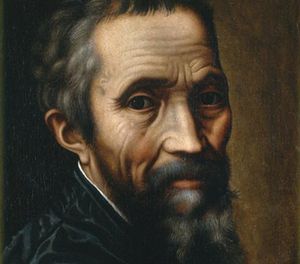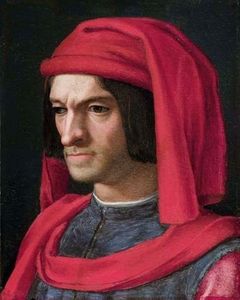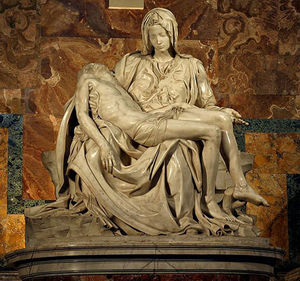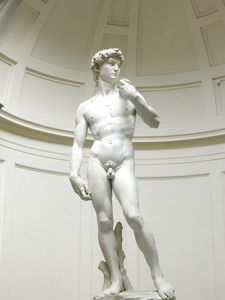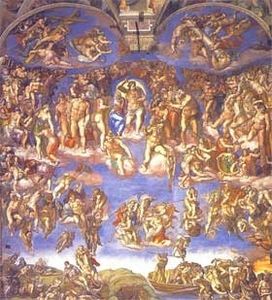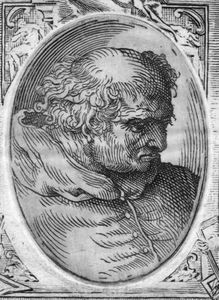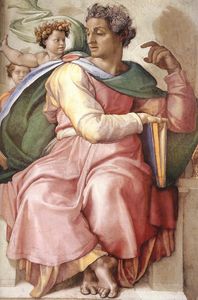Michelangelo Critical Reception
- Full Name:
- Michelangelo di Lodovico Buonarroti Simoni
- Short Name:
- Michelangelo
- Alternative Names:
- Michelangelo
- Date of Birth:
- 06 Mar 1475
- Date of Death:
- 18 Feb 1564
- Focus:
- Paintings, Sculpture, Architecture, Drawings
- Mediums:
- Oil, Wood, Stone, Other
- Subjects:
- Figure, Fantasy
- Art Movement:
- Renaissance
- Hometown:
- Unknown City of Tuscany, Italy
- Living In:
- Florence, Italy
- Architecture:
- Saint Peter's Basilica
- Michelangelo Critical Reception Page's Content
- Introduction
- During Life
- After Death
Introduction
During his lifetime Michelangelo was one of the most revered artists in all of Europe. Starting in Florence he quickly gained fame among his town folk and at the young age of fourteen he was invited to live at court with the ruler, Lorenzo the Great. His nationwide fame did not grow until he created an Eros to look a century older than it was; although the supposedly antique work was false people all over Rome admired the beauty of the piece.
Until the year 1534 Michelangelo moved between Florence and Rome many times to work on different commissions. He eventually relocated to Rome permanently and began his final work in the Sistine Chapel. In his later years Michelangelo was plagued by rumors that he was going senile, but it was during this period that he successfully oversaw the building of St. Peter's Basilica. Today Michelangelo is remembered as one of the greatest artists of all time.
Michelangelo During Life
During his early years Michelangelo was praised and admired for his great skill. Even as an apprentice he was salaried because of his unusual talent and was soon invited to live at court. His work from a young age displayed brilliant talent and the critical reception from all who saw it was highly impressive.
After Lorenzo the Great died Michelangelo was invited to live at court by the old ruler's son, who remembered the talent of the artist. However the family was soon run out of Florence to Bologna. It was in Bologna that Michelangelo created the supposedly antique Eros that got him into trouble with a Roman Cardinal. Nonetheless it resulted in Michelangelo moving to Rome and the critical reception of the fake was so good it gained him many admirers in the capital city. It was only the Cardinal that originally bought the work who refused to buy Michelangelo's work again.
After relocating to Rome Michelangelo created the Pieta that now stands in St. Peter's Basilica and was heralded as a masterpiece by all who saw it. One evening a group of Lombards were stood by the sculpture, admiring it and saying that it had been completed by a fellow countryman. In a rage Michelangelo later went back to the Pieta and chiseled his signature into it. This was highly unusual for Michelangelo, as he rarely signed his work.
Michelangelo returned to live in Florence among his family where it was hard for other artists to escape his influence. When Leonardo da Vinci had left the city Michelangelo was still a young boy, however when he returned in the 1500s it was Michelangelo who had the monopoly on the art sphere.
In 1501 Michelangelo began creating his sculpture David which was completed in 1504 to great critical acclaim. The Florentines were so impressed by the large statue that they held a vote about where they should place it. It was eventually housed outside of the Palazzo dei Priori so that all of the residents would be able to admire it. Sadly this resulted in some erosion to the magnificent sculpture.
Michelangelo continued to receive critical reception throughout his career and in the early 1500s he was asked to paint the ceiling of the Sistine Chapel. The Pope's critical reception of the completed work was excellent, which is why he later asked Michelangelo to return and paint The Last Judgment. Although this piece was popular the nude figures were perceived by the prudish Cardinals to be highly inappropriate and eventually the artist Daniele da Volterra was commissioned to paint over the genitalia.
After he fled Florence Michelangelo continued to work on the Medici Chapel from Rome. The Medici chapel was the only architectural project of Michelangelo's that was almost completed but because it wasn't, this affected its critical reception.
Many viewers criticized the fact that the times of day sculptures appear to be falling from their perches. In fact in Michelangelo's original design they were sat on a platform just off of the floor, and it would have looked quite different if Michelangelo had completed the chapel.
The artist continued to receive many important commissions and in the mid 1800s he agreed to complete Bramante's vision of St, Peter's Basilica. Although some of the grounding had already been placed the elderly Michelangelo changed the size of the dome and the inner sanctum. Whilst completing the building, Michelangelo was criticized by many due to his old age and supposed eccentricity. Nevertheless, although Michelangelo passed away before the Basilica was finished art fans were highly impressed by his work on the dome in particular.
Michelangelo After Death
It is hard to measure the critical reception Michelangelo received after he passed away. Immediately after his death his fellow countrymen revered his work and wanted him to be buried in Rome. However the Florentines were unhappy with this arrangement and stole his body for their own city and Michelangelo's own chosen burial place. He was considered one of Italy's most talented artists, and received the critical reception as such.
Today Michelangelo is seen as one of the greatest artists of all time; a Renaissance man he excelled at painting, sculpture and architecture. Numerous books have been written on the subject of Michelangelo's work and there are countless biographies available. His popularity has never waned and his supposed genius has never been questioned.
Michelangelo's art is shown all over the world to great critical acclaim and annually admirers of his work make trips to Italy where the majority of his legacy is located.

